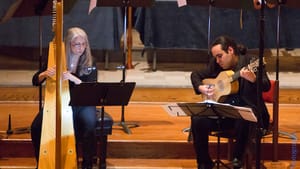Stay in the Loop
BSR publishes on a weekly schedule, with an email newsletter every Wednesday and Thursday morning. There’s no paywall, and subscribing is always free.
Música para la iglesia
Piffaro presents 'Sacred Winds: Cathedral Music for a Spanish Band'

Philadelphia’s Renaissance Wind Band, Piffaro, likes to experiment with stratagems that place Renaissance music in its historical context. For their latest concert, they supplemented the music with a simple but effective device: a screen on one side of the performance area that accompanied each piece with relevant texts and images.
The text sequences were especially significant. Though this was a purely instrumental concert devoted to Spanish cathedral music, a 16th-century audience would have associated many of these pieces with familiar words. They would have responded the same way we respond when we hear an orchestra play an instrumental version of “America the Beautiful” or “The Battle Hymn of the Republic.”
Hearing with your eyes
The opening, “La Guerre,” would have sounded like a typical Renaissance battle piece without the text; the words marching across the screen connected it to a less obvious theme. Its clatter and heraldry depicted a struggle for the soul, with Christ in a bloody garment leading the army of good against forces of evil. Heard that way, with the text adding imagery to the music, it was a powerful expression of the deep piety behind much of the program.
Piffaro models itself on bands employed by towns and churches during the Renaissance. For this concert, they returned to one of their roots and sampled the repertoire of a 16th-century Spanish church band, the “Sacred Winds.” They crammed 37 pieces into a well-paced two-hour program. With their usual showmanship, they alternated big, lively pieces with quieter interludes like a solemn “Crux Fidelis (Faithful Cross)” for eight resonant recorders.
At one point, the screen conveyed some 16th-century advice to music directors: they were admonished to change instruments frequently, because listeners become annoyed when they always hear the same ones.
It’s a philosophy Piffaro has applied ever since its first concert in 1980. Piffaro’s regulars all play several instruments, just like their Renaissance predecessors, and that eclecticism got a full workout here. In one set of four pieces, they played seven different kinds of Renaissance instruments.
One-of-a-kind performance

"Pange Lingua," a Latin hymn sung on the feast of Corpus Christi, played during a long processional and the orchestration would have changed as the procession circled the cathedral. Piffaro played three versions with four instrumental groups: harp and cornetto (a wooden trumpet with finger holes like a recorder); cornetto, sackbuts (an early trombone), and shawms (a strong reed instrument); vihuela (a small guitar); and two bagpipes, joined by two recorders.
I think we can assume, with some confidence, that Piffaro’s concerts offer Philadelphians their only opportunity to hear a bagpipe-and-recorder quartet.
This was the final concert in a season Piffaro has devoted to Spanish music from the time of Cervantes. The season began in October with a spectacular, carefully choreographed program that presented a musical picture of Don Quixote and his world. In December, Piffaro recreated the atmosphere of a 16th-century Spanish Christmas Eve. In February, they ventured into theater music that Don Quixote might have heard.
When you read the entertaining program notes accompanying Piffaro’s concerts, it’s easy to overlook the scholarship that supports everything its musicians undertake. The music for this concert came from a huge manuscript that lay hidden for centuries in the Collegiate Church of San Pedro in the village of Lerma. Its scores are written in a Renaissance notation, with no bar lines and no information on instrumentation. The musicians must apply an encyclopedic knowledge of Renaissance performance practices and combine it with their own sense of good musicianship. Then they have to turn all that intellectual effort into a well-played, satisfying performance. Musicians who specialize in the Renaissance and Baroque music are a rare, valuable mix of scholars and performers.
What, When, Where
Sacred Winds: Cathedral Music for a Spanish Band. Piffaro, the Renaissance Wind Band. Joan Kimball, Robert Wiemken, artistic directors. March 31, 2017, at the Trinity Center for Urban Life, 2212 Spruce Street, Philadelphia. (215) 235-8469 or piffaro.org.
Sign up for our newsletter
All of the week's new articles, all in one place. Sign up for the free weekly BSR newsletters, and don't miss a conversation.

 Tom Purdom
Tom Purdom